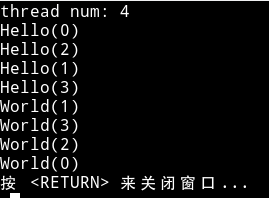Bost asio库与线程池的使用
Boost.Asio 有两种支持多线程的方式
第一种方式比较简单:在多线程的场景下,每个线程都持有一个io_context,并且每个线程都调用各自的io_context的run()方法。
另一种支持多线程的方式:全局只分配一个io_context,并且让这个io_context在多个线程之间共享,每个线程都调用全局的io_service的run()方法。
每个线程一个 I/O Service
让我们先分析第一种方案:在多线程的场景下,每个线程都持有一个io_context (通常的做法是,让线程数和 CPU 核心数保持一致:hardware_concurrency() )。那么这种方案有什么特点呢?
在多核的机器上,这种方案可以充分利用多个 CPU 核心。
某个 socket 描述符并不会在多个线程之间共享,所以不需要引入同步机制。
在 event handler 中不能执行阻塞的操作,否则将会阻塞掉io_service所在的线程。
直接上代码:
#include <boost/asio.hpp>
#include <string>
#include<memory>
#include <boost/unordered_map.hpp>
class ThreadPool {
public:
typedef boost::asio::io_context ioContext;
typedef boost::asio::io_context::work Work;
ThreadPool(std::size_t size = std::thread::hardware_concurrency())
:my_pool_size{size}
{
for (std::size_t i = 0; i < size; ++i){
std::shared_ptr<ioContext> io_context = std::make_shared<ioContext>();
std::shared_ptr<Work> work =std::make_shared<Work>();
m_ioContextList.push_back(io_context);
m_workList.push_back(work);
}
//开启线程池,一个线程一个I/O 服务
for (int i = 0; i < size ; i++) {
std::thread runThread([=] {
m_ioContextList[i]->run();
});
runThread.detach();
//runThread.post();
}
}
// 使用 round-robin 的方式返回一个 io_service
boost::asio::io_context &getIoContext()
{
//通过这个函数分配io_context
ioContext& io_context = *m_ioContextList[m_io_context_pos++];
if (m_io_context_pos == my_pool_size - 1)
m_io_context_pos = 0;
return io_context;
}
void stop(){
for (int i = 0; i < my_pool_size; i++)
{
m_ioContextList[i]->stop();
}
}
private:
std::vector<std::shared_ptr<ioContext>> m_ioContextList;
std::vector<std::shared_ptr<Work>> m_workList;
size_t my_pool_size;
size_t m_io_context_pos; //依次分配io_context
};
一个 I/O Service 与多个线程
另一种方案则是先分配一个全局io_context,然后开启多个线程,每个线程都调用这个io_context的run()方法。这样,当某个异步事件完成时,io_context就会将相应的 event handler 交给任意一个线程去执行。
然而这种方案在实际使用中,需要注意一些问题:
在 event handler 中允许执行阻塞的操作 (例如数据库查询操作)。
线程数可以大于 CPU 核心数,譬如说,如果需要在 event handler 中执行阻塞的操作,为了提高程序的响应速度,这时就需要提高线程的数目。
由于多个线程同时运行事件循环(event loop),所以会导致一个问题:即一个 socket 描述符可能会在多个线程之间共享,容易出现竞态条件 (race condition)。譬如说,如果某个 socket 的可读事件很快发生了两次,那么就会出现两个线程同时读同一个 socket 的问题 (可以使用strand解决这个问题)。
也是直接上代码:
#include <functional>
#include <iostream>
#include <mutex>
#include <thread>
#include <vector>
#define BOOST_ASIO_NO_DEPRECATED
#include <boost/thread/thread.hpp>
#include <boost/asio.hpp>
class ThreadPool {
public:
// the constructor just launches some amount of threads
explicit ThreadPool(std::size_t size) :
io_context_(size),
strand_(io_context_),
work_guard_(boost::asio::make_work_guard(io_context_))
{
// one io_context and multi-thread
for (std::size_t i = 0; i < size; ++i) {
// all the threads do is execute the io_context::run()
group_.create_thread([&](){ io_context_.run(); });
}
}
// the destructor joins all threads
~ThreadPool() {
// Once the work object is destroyed, the service will stop.
work_guard_.reset();
group_.join_all();
}
// Add new work item to the pool.
template<class F>
void Enqueue(F f) {
// Submits a completion token or function object for execution.
boost::asio::post(io_context_, f);
}
private:
boost::thread_group group_;
boost::asio::io_context io_context_;
boost::asio::io_context::strand strand_;
// prevent the run() method from return.
typedef boost::asio::io_context::executor_type ExecutorType;
boost::asio::executor_work_guard<ExecutorType> work_guard_;
};
// For output.
std::mutex g_io_mutex;
int main ( int argc, char* argv[] ) {
int thread_num = std::thread::hardware_concurrency();
std::cout << "thread num: " << thread_num<< std::endl;
ThreadPool pool(thread_num);
// Queue a bunch of work items.
for (int i = 0; i < 4; ++i) {
pool.Enqueue([i] {
{
std::lock_guard<std::mutex> lock(g_io_mutex);
std::cout << "Hello" << "(" << i << ") " << std::endl;
}
std::this_thread::sleep_for(std::chrono::seconds(1));
{
std::lock_guard<std::mutex> lock(g_io_mutex);
std::cout << "World" << "(" << i << ")" << std::endl;
}
});
}
return 0;
}
运行结果





















 66
66











 被折叠的 条评论
为什么被折叠?
被折叠的 条评论
为什么被折叠?








